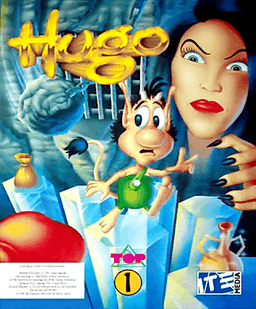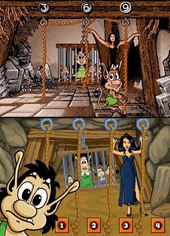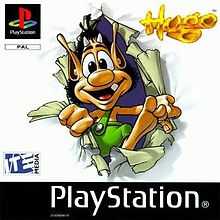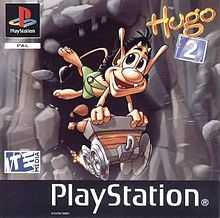Hugo (video game)
| Hugo | |
|---|---|
 Cover of the 1996 PC CD-ROM Hugo | |
| Developer(s) | Silverrock Productions (ITE) |
| Publisher(s) | Silverrock Productions (ITE) |
| Producer(s) | Ivan Sølvason |
| Programmer(s) | Esben Krag Hansen Henrik Christensen Martin Pedersen |
| Artist(s) | Niels Krogh Mortensen Lars Krogh Mortensen Torben B. Larsen |
| Composer(s) | Thomas Engell |
| Series | Hugo |
| Platform(s) | Amiga, Apple Macintosh, C64, Game Boy Color, PC, PlayStation |
| Release date(s) | 1991–2000 |
| Genre(s) | Action |
| Mode(s) | Single-player |
| Distribution | Floppy disks, CD-ROM |
There are several Hugo video games based on early episodes of Interactive Television Entertainment's TV show Hugo, part of the international Hugo franchise. From 1990 to 2000, ITE developed and released versions for Amiga, Commodore 64 and PC and the Game Boy, Game Boy Color and PlayStation consoles. In 2011, Krea Media published a series of mobile game remakes for Android.
The Hugo games resemble those on the television show; in almost all of them, the player guides the titular protagonist (a small, friendly troll named Hugo) to save his wife and children from the witch Scylla. To rescue his family, Hugo must navigate safely through dangerous environments in various minigame scenarios.
Amiga, PC and PlayStation games
The first Hugo game, Skærmtrolden Hugo, was originally developed by Thomas Villadsen and Uffe Jakobsen[1] for SilverRock Productions (which was renamed Interactive Television Entertainment in 1992). Skærmtrolden Hugo was released for the Commodore 64 in 1990, and for the Amiga shortly afterwards. The game took place in a gold mine, which Hugo had to navigate to collect treasure.[2] The game mechanics were fairly simple, and a complete game could take less than ten minutes.

The next releases were the 1992 Amiga games Hugo - På Nye Eventyr: Del 1[3] and its sequel, Hugo - På Nye Eventyr: Del 2.[4] These were re-released as a 1994 compilation, Hugo (Hugo På Nye Eventyr),[5] and ported to the PC in 1995-1996.[6] Both games were similar to Skærmtrolden Hugo; using game mechanics, the player completes arcade sequences to collect points and avoid obstacles. The ending minigames are identical.[7]
Other PC releases, including Hugo 3 to Hugo 6, Hugo: Wild River (1998)/[8] and upgraded compilations Hugo Gold (1998), Hugo Platin (1999) and Hugo XL (1999),[9] were partially incorporated into 2000's Hugo - Die Geburtstagsparty and Hugo Safari (both of which were also based on newer Hugo works) and the Hugo Classic Collection (compiling the first four titles).[10] The latter contained Hugo Classic 1-4, based on the original series, and Hugo Classic 5-7, which consisted of newer works.
| Hugo (Playstation) | |
|---|---|
 Cover of the 1998 PlayStation game Hugo | |
| Developer(s) | ITE Media |
| Publisher(s) | ITE Media |
| Producer(s) | Ivan Sølvason Lars Rikart Jensen Troels Gram |
| Designer(s) | Niels Krogh Mortensen Troels Gram Lars Rikart Jensen |
| Artist(s) | Chadi Freigeh John Madsen Lars Krogh Mortensen |
| Composer(s) | David A. Filskov Christian Steen Jensen |
| Platform(s) | PlayStation |
| Release date(s) |
|
| Distribution | CD-ROM |
| Hugo 2 (Playstation) | |
|---|---|
 Cover of the 2000 PlayStation game Hugo 2 | |
| Developer(s) | ITE Media |
| Publisher(s) | ITE Media |
| Producer(s) | Ivan Sølvason Lars Rikart Jensen Piet N. Kargaard |
| Designer(s) | Mario Gomes Peter Eide Paulsen Poul Engelbrech Madsen |
| Artist(s) | Claus Friese Chadi Freigeh John Madsen |
| Composer(s) | David A. Filskov Christian Steen Jensen Klaus Mulvad Nielsen |
| Platform(s) | PlayStation |
| Release date(s) |
|
The two PlayStation games of 1998–2000, which reused the titles Hugo[11] and Hugo 2,[12] are compilation remakes of the computer games. They feature improved graphics and sound (including musical tracks for each stage) and—in Hugo 2—a rendered intro sequence.
Plot
In the games' story, the evil witch Scylla (also known as Sculla and named differently in some countries, including "Afskylia" in the original Danish version, "Hexana" in the German version, "Maldicia" in the Spanish version, "Mordana" in the Croat version, and "Sila" in the Turkish version) kidnaps and imprisons Hugo the troll's wife Hugoline and their three children (Rit, Rat and Rut) because she needs them for a magic beauty treatment. Hugo must rescue them and bring peace to the woods, despite the obstacles the witch places in his path on the way to her skull cave.
During the games Hugo (voiced in Danish by Michael Brockdorf and German by Michael Habeck, Oliver Grimm and Oliver Baier) and Scylla (voiced in Danish by Winnie Engell and in German by Karin Kernke) communicate with the player with digitized speech. They can also knock on (or scratch) the screen from the inside, breaking the fourth wall.
Gameplay
The player must complete a number of minigames and guessing games to rescue Hugolina and the children; most have 2.5D graphics and are controlled with button presses. In order of release:
- "Labyrinth": Hugo must find his way through a labyrinth, avoiding dynamite and mined wagons before a box of TNT destroys the maze, and cross a bridge before facing three doors (one of which holds a prize). It appeared in Skærmtrolden Hugo and was used in for Hugo Gold, Hugo Die Geburtstagsparty[13] and in a revised form in Hugo Retro Mania.
- "Mountaineering": Hugo runs up a mountain, dodging rolling boulders while trying to collect bags of gold. It appeared in Hugo - På Nye Eventyr, Hugo I/II (PC), Hugo Gold, Hugo XL, Hugo Safari, Hugo Classic 1 and Hugo for the PlayStation.[14]
- "Handcar": Hugo finds an old track leading to Scylla's cave. The player helps the troll and his handcar reach their destination by changing tracks, dodging oncoming steam trains and collecting bags of gold. It appeared in Hugo - På Nye Eventyr and Hugo I/II (PC), Hugo Gold, Hugo XL, Hugo Die Geburtstagsparty, Hugo Classic 1 (PC), Hugo (PlayStation), and in a revised form in Hugo Troll Race.[15]
- "Plane": The troll flies a biplane through a thunderstorm caused by Scylla, avoiding the storm and mines and collecting gold. It appeared in Hugo - På Nye Eventyr Del 2 and Hugo I/II (PC), and remade for Hugo Gold, Hugo XL, Hugo Safari, Hugo Classic 1 and Hugo (PlayStation).[16]
- "Forest": Hugo wanders through a dark forest, avoiding traps set up by Scylla. It appeared in Hugo - På Nye Eventyr Del 2 and Hugo I/II (PC), Hugo Gold, Hugo XL, Hugo Classic 1 and Hugo for the PlayStation.[17]
- "Ice Cavern": Hugo finds a secret back entrance to the witch's lair, and must keep moving across mobile ice pillars while collecting three jars. It appeared in Hugo 3 (PC), Hugo Gold, Hugo 2 (PlayStation), Hugo Platin and Hugo Die Geburtstagsparty.[18]
- "Lumberjack": Hugo floats downstream on floating logs, hopping between logs to avoid branches and collect sacks of gold; if he stays on a log too long, it sinks. It appeared in Hugo 3, Hugo Gold, Hugo XL and Hugo (PlayStation).[19]
- "Scuba": Hugo dives in a river, avoiding fish, crabs and octopi and collecting treasure chests; he must surface for air, and turn to avoid waterfalls. It appeared in Hugo 3, Hugo Gold, Hugo XL and Hugo for PlayStation.[20]
- "Skateboard": Hugo skates down a wooden half-pipe, avoiding broken sections (followed by boulders) and collecting bags of gold. It appeared in Hugo 3, Hugo Gold, Hugo XL, Hugo Die Geburtstagsparty and Hugo for PlayStation.[21]
- "Ballooning": Hugo steers a hot-air balloon to avoid canyons, spikes and collapsing cliffs. When his balloon punctures, the player must control it through a tunnel without hitting its walls. It appeared in Hugo 4, Hugo Platin and Hugo Classic 2 (PC).[22]
- "Dolmen Cave": A revised Labyrinth where Hugo navigates an underground maze to reach a mountaintop. The player must find the right path quickly, avoiding traps before Scylla floods the maze. It appeared in Hugo 4, Hugo Platin, Hugo Die Geburtstagsparty and Hugo Classic 2 (PC).[23]
- "Motorcycle": Hugo navigates an old mountain road, dodging goats, potholes, rocks and other obstacles. The player must collect gasoline while keeping an eye on the map and directing Hugo. It appeared in Hugo 4, Hugo Platin, Hugo Die Geburtstagsparty and Hugo Classic 2.[24]
- "Snowboarding": Hugo snowboards down the mountain, following tracks towards Scylla's lair. Unfortunately, the witch knows Hugo's plans and has started an avalanche, adding a ticking clock to the game. The track down the hill often splits, leaving some dead ends and passing through fast and slow slopes. Hugo swings on his snowboard, avoiding rolling snowballs and steep chasms while collecting gold. This was released in Hugo 4, then remade twice, first for both Hugo Platin and Hugo Classic 2, and then for Hugo 2 (PlayStation).[25]
- "Parachute": Hugo parachutes to the witch's hideout in the forest, avoiding birds and storm clouds while collecting bags of gold. It appeared in Hugo 5, Hugo Platin and Hugo Classic 3 for PC.[26]
- "Cliffhanger": The troll climbs a mountain, avoiding gargoyles, asteroids and dynamite and collecting bags of gold. It appeared in Hugo 5, Hugo Platin, Hugo Die Geburtstagsparty, Hugo Classic 3 and Hugo 2 for the PlayStation.[27]
- "Wood Jumping": Hugo crosses a gorge by hopping across flat-topped tree trunks and an oddly-placed bridge, avoiding dynamite, beavers and steel traps. On the edge of the track are owls and frogs, which the player must remember. It appeared in Hugo 5, Hugo Platin and Hugo Classic 3.[28]
- "Sledge": Hugo sleds down a hill, avoiding birds and snowmen while collecting bags of gold. It appeared in Hugo 5, Hugo Platin, Hugo Classic 3 and the PlayStation Hugo 2.[29]
- "Mine Track": Hugo barrels down a mineshaft in search of an exit, avoiding obstacles in the ceiling and corridors and collecting gold. It appeared in Hugo 6, Hugo Die Geburtstagsparty, Hugo Classic 4 and Hugo 2 for the PlayStation.[30]
- "Moor": The troll must cross a moor to reach Scylla's lair, avoiding mud holes and colonies of bats, before solving a test. It appeared in Hugo 6, Hugo Classic 4 and Hugo 2 for the PlayStation.[31]
- "Boulders": Hugo flees from enormous boulders, avoiding obatacles such as dead ends, tree roots and lava pits. It appeared in Hugo 6 and Hugo Classic 4.[32]
- "Wild River": Hugo rides a barrel downstream, avoiding whirlpools and boulders. There are periodic waterfalls, for which Hugo must shut the lid of his barrel and direct himself left or right, using a map to find his way. It appeared in Hugo 6, Hugo Die Geburtstagsparty and Hugo Classic 4.[33]
If the players manage to complete the journey and reach their destination, Hugo proceeds to the final minigame, which doubles the score if he succeeds:
- "Lightning Bolts": Hugo must hop through a large chessboard to collect a key and open a door, avoiding lightning bolts hurled by Scylla. It appeared in Hugo 3, Hugo 4, Hugo 5, Hugo 6, Hugo Gold, Hugo Platin, Hugo Die Geburtstagsparty, Hugo Safari, Hugo 2 (PlayStation) and Hugo Classic 1-4.[34]
- "Key": Hugo must select the correct key to open Scylla's treasure chest; if he guesses incorrectly, a fence rises to imprison him. It appeared in Hugo 3, Hugo 4, Hugo 5, Hugo 6, Hugo Gold, Hugo Platin, Hugo Die Geburtstagsparty, Hugo Safari and Hugo Classic 1-4.[35]
- "Ropes": In front of Scylla and a cage imprisoning his family, Hugo guess-selects one of three ropes (one of which will bind and defenestrate the witch or transform her into a buzzard, and free his family). If he chooses incorrectly, he will be bound and springboard-ejected out of window instead of Scylla.[36] It appeaed in Hugo - På Nye Eventyr, Hugo I/II(PC), Hugo 3, Hugo 4, Hugo 5, Hugo 6, Hugo Gold, Hugo Platin, Hugo XL, Hugo Die Geburtstagsparty, Hugo Safari, Hugo (PlayStation) and Hugo Classic 1-4.
Some games feature alternative final minigames that do not take place in Scylla's lair:
- "Apple Harvest": Two of Hugo's children throw apples from a tree; Hugo tries to catch enough in a basket to make juice. It appeared in Hugo Platin.[37]
- "Magic Hands": A shell game in which the player watches one of Hugo's children place a bead under a shell and shuffle several shells and must select the shell with the bead under it. It appeared in Hugo Platin, Hugo XL and Hugo for the PlayStation.
Game Boy games
Hugo and Hugo 2[38] were released for the Game Boy by Laguna Video Games in 1995–1996 (or 1994–1997). Both of them are very different from the classic computer games, despite sharing the same title. In 1999, Hugo 2 was ported by Bit Managers and Infogames for the Game Boy Color; Hugo 2½,[39] as the port was named, featured simplified graphics and gameplay.
Plot
In the first of these (which is actually a conversion of Mickey Mouse by Kemco),[40] Hugo's wife Hugolina gets kidnapped by the Horned King, ruler of the castle Arbarus, after agreeing to his invitation; and Hugo has to free her and defeat the King. In the second, the goal is not to rescue the troll's family, but rather to help Hugo himself escape, as Scylla keeps him prisoner in her own magic castle.
Gameplay
Both games are side-scrolling platform games. In Hugo, Hugo escapes from a castle by walking upstairs, crawling through pipes and passing through dangerous traps. In Hugo 2, he escapes from a castle by collecting gold bags and avoiding pits.
Reception
| Reception | ||||||||||||||||||
|---|---|---|---|---|---|---|---|---|---|---|---|---|---|---|---|---|---|---|
| ||||||||||||||||||
The original games, unlike the later PlayStation versions, received tepid reviews. According to the Spanish magazine pcmanía, while Hugo is "not a bad game," it is "a bit bland and repetitive, especially since the video game version only differs from television [game] in its difficulty."[48]
Other reviewers were harsher. Arcade said about the PlayStation releases, "Advertised as being 'designed for children aged 6+', Hugo will come off as simplistic at best, patronising at worst - a real shame given the quality of edutainment titles that could be ported from PC and Mac."[49]
PlayStation Official Magazine listed Hugo (described as "bloody rubbish") atop its list of worst PlayStation characters.[50] In 2012, Game Informer made a Replay-section retro video poking fun at the PlayStation Hugo and Bubsy 3D.[51]
Krea Media remakes
See also
- Hugo (franchise)
- Other Hugo video games
References
- ↑ "Commodore Fan Gazette 03 2013 Lowres". Archive.org. Retrieved 19 November 2014.
- ↑ "Skærmtrolden Hugo". Lemon Amiga.
- ↑ "Hugo P Nye Eventyr: Del 1". Playright.dk. Retrieved 19 November 2014.
- ↑ "Hugo På Nye Eventyr Del 2". Lemon Amiga.
- ↑ "Hugo P Nye Eventyr". Playright.dk. Retrieved 19 November 2014.
- ↑ "Games-Historie". Hugo-troll.de (in German).
- ↑ "Hugo På Nye Eventyr". Lemon Amiga.
- ↑ "Hugo: Wild River". Playright.dk. Retrieved 19 November 2014.
- ↑ "Compliation". Hugo-troll.de (in German).
- ↑ "Classic Collection". Hugo-troll.de (in German).
- ↑ "Hugo (1998)". Playright.dk. Retrieved 19 November 2014.
- ↑ "Hugo 2 (2000)". Playright.dk. Retrieved 19 November 2014.
- ↑ Nico Schimmelpfennig. "Labyrinth". Hugo-troll.de. Retrieved 2012-07-15.
- ↑ "Berg". Hugo-troll.de (in German).
- ↑ Nico Schimmelpfennig. "Draisine". Hugo-troll.de. Retrieved 2012-07-15.
- ↑ Nico Schimmelpfennig. "Flieger". Hugo-troll.de. Retrieved 2012-07-15.
- ↑ Nico Schimmelpfennig. "Wald". Hugo-troll.de. Retrieved 2012-07-15.
- ↑ "Eishöhle". Hugo-troll.de (in German).
- ↑ Nico Schimmelpfennig. "Floßfahrt". Hugo-troll.de (in German).
- ↑ Nico Schimmelpfennig. "Taucher". Hugo-troll.de. Retrieved 2012-07-15.
- ↑ Nico Schimmelpfennig. "Skateboard". Hugo-troll.de. Retrieved 2012-07-15.
- ↑ Nico Schimmelpfennig. "Ballonfahrt". Hugo-troll.de. Retrieved 2012-07-15.
- ↑ Nico Schimmelpfennig. "Dolmenhöhle". Hugo-troll.de. Retrieved 2012-07-15.
- ↑ Nico Schimmelpfennig. "Motorrad". Hugo-troll.de. Retrieved 2012-07-15.
- ↑ "Snowboard". Hugo-troll.de (in German).
- ↑ Nico Schimmelpfennig. "Fallschirm". Hugo-troll.de. Retrieved 2012-07-15.
- ↑ Nico Schimmelpfennig. "Kletterwand". Hugo-troll.de. Retrieved 2012-07-15.
- ↑ Nico Schimmelpfennig. "Pfahlspringen". Hugo-troll.de. Retrieved 2012-07-15.
- ↑ "Schlittenfahrt". Hugo-troll.de (in German).
- ↑ "Berkwerk". Hugo-troll.de (in German).
- ↑ Nico Schimmelpfennig. "Moor". Hugo-troll.de. Retrieved 2012-07-15.
- ↑ Nico Schimmelpfennig. "Steinpfad". Hugo-troll.de. Retrieved 2012-07-15.
- ↑ "Wilder Fluss". Hugo-troll.de. Retrieved 2012-07-15.
- ↑ Nico Schimmelpfennig. "Blitz". Hugo-troll.de. Retrieved 2012-07-15.
- ↑ Nico Schimmelpfennig. "Schlüsselszene". Hugo-troll.de. Retrieved 2012-07-15.
- ↑ Nico Schimmelpfennig. "Seilszene". Hugo-troll.de. Retrieved 2012-07-15.
- ↑ Nico Schimmelpfennig. "Apfelernte". Hugo-troll.de. Retrieved 2012-07-15.
- ↑ "Hugo 2". Playright.dk. Retrieved 19 November 2014.
- ↑ "Hugo 2 1/2". Playright.dk. Retrieved 19 November 2014.
- ↑ "Hugo". Playright.dk. Retrieved 19 November 2014.
- ↑ Hugo: Hugo der Troll findet dich toll! (German)
- ↑ Hugo game review, Official UK PlayStation Magazine, Future Publishing issue 42
- ↑ COMPuter 2/1992 (Danish)
- ↑ "Micromania Segunda Epoca (Spanish) Issue 66". Archive.org. Retrieved 2013-12-05.
- ↑ "Micromania Segunda Epoca (Spanish) Issue 56". Archive.org. Retrieved 2013-12-05.
- ↑ 46.0 46.1 "Hugo (PlayStation) - N.i.n.Retro (New is not Retro) v3". Ninretro.de. Retrieved 2014-01-18.
- ↑ Świat Gier Komputerowych 5/1994 (Polish)
- ↑ "Francisco Delgada, "Igualito que el tele", Pcmanía 3, p.52.
- ↑ "Arcade - Issue 03 (1999-02)(Future Publishing)(GB)". Archive.org. Retrieved 2013-12-05.
- ↑ Top Ten Most Wanted feature, Official UK PlayStation Magazine, Future Publishing issue 108.
- ↑ "Replay - Bubsy 3D". Youtube.com. 2012-02-05. Retrieved 2013-08-14.
External links
- Official website
- Hugo at MobyGames
- Hugo at Giant Bomb
- Amiga Hugo games at HOL database
- (German) Classic Hugo games at Hugo-Troll.de
| ||||||||||